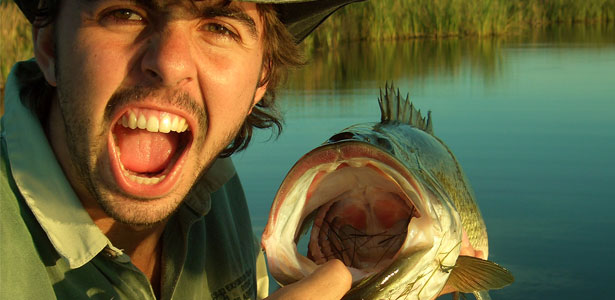
Why is it that the bass fishing world believes that autumn is the time for really big bass? The question popped up recently while we were staring out of our waterside lapa at yet another day of incessant rain.
We’re not averse to fishing in the rain. Indeed, we have had many highly successful bass sessions sitting drenched in a boat while the drops plopped all around. Rain water, we believe, increases the available oxygen content in the water, which is advantageous to a predatory fish such as a bass, and in addition the drops falling on the surface create sufficient surface disturbance so the fish cannot easily see what’s happening above them. The overcast sky also means that there are no shadows. We have found the fish in such conditions to be scattered and also highly active, and the bait of choice, at least according to our logbooks, are crankbaits.
But to get back to our opening statement, really big bass can be caught at any time of the year. “You just have to be in the right place at the right time with the right presentation!” Yeah right!
We will agree however, that the bass’ behaviour pattern during the autumn months – all things being equal – does make them somewhat easier to locate, because they are locating to deeper water and structures. You’ll still find fish in the shallows and all the other traditionally accepted spots, but for shorter periods. Bear in mind that the water is cooling all the time, even though it may be only fractions of degrees; on top of this the daylight hours are diminishing.
The reason why autumn is considered big bass season , we reckon, is because it is the older (bigger) bass that start moving off to deeper structures way before the cooler weather wakes up the immature fish which are still hanging around the summer spots. The result? You have increasing numbers of mature, big bass moving to their winter habitat. In autumn the bass’ behaviour patterns do certainly change, and if you play your cards right you can certainly land your next ‘PB’.
So, if we reckon that the bass are scattered and in transition between shallow and deep water, what bait do you reckon is the most likely to produce fish? Crankbaits, of course! This is not the time to be messing about with plastics, whether they are prey imitations such as frogs, worms and crawdads, or those “aliens”, the creature baits. No, what we want now is a crankbait selection that can be used to cover the total water column.
There are many to choose from, and since we do not in this column mention trade names, go through your tackle box or re-visit your tackle store. You’ll need crankbaits for shallow depths, say to around four feet, from four to ten feet and then deeper. Colours in South Africa that are favourites include firetiger, perch, tilapia and bluegill, but never ever ignore the good old red head.
While the shallower areas can also produce a nice size bass, we see in our logbooks that the majority of big bass, those of two kilograms and heavier, were taken in deeper water off shore. For this strategy to work choose baits with a long lip that can dive to ten feet and more on a steady retrieve. Off shore structures are the target, such as humps, islands, submerged timber, man made reefs (such as stacks of tyres that have been dumped in a particular spot) and the banks of submerged river beds. If you have even wondered why a fishfinder is a valuable piece of equipment to a bass angler, this is where it really comes into its own. Use it to locate such spots and if need be spend an hour or so before you cast the first bait to search out such spots. The time and effort will be well rewarded.
While there will always be a place for count down crankbaits, we prefer the diving/floating models, and just recently we were introduced to crankbaits that utilise a square lip, which evidently makes it much more snag free than the ones with the traditional round lip. The point we want to make is that when you feel your floating crankbait bump into something, don’t panic, just give it slack line and it should float free.
It may sound surprising, but the preferred tactic is to actually make the bait make contact with structure. In particular a hard type of structure, such as submerged boulders and rocks, the filling next to a dam wall, sunken timber , bridge pilings and so on. It is rare for a crankbait to get hung on this type of structure, but beware of witchweed and grass mats! We have yet to find a crankbait that can wiggle its way through these without one of the trebles getting caught. But we cannot always fish only where it suits us, so we do recommend that you get one of those lure retrievers available at tackle dealers. It consists of a worm-like lure contraption mounted on a telescopic pole handle. You slide this down the line until it hits against the stuck bait, then tap it free.
A tactic we have often used in relatively open water is to retrieve the bait quite fast for three to five turns of the reel handle, then stop and let the bait float or suspend for up to ten seconds. Then you rev it up again for another five turns and stop again. This is repeated all the way back to the boat. You can also dip the rod into the water while turning the handle, then stop and lift the rod out of the water to make the bait rise more quickly. This is a great tactic to get a roving bass’ attention!
Here is a tactic that was shown us by a most competent guide in Florida: we were in about twenty feet of water over a sandy flat; he selected a floating crankbait and cranked it all the way until it hit bottom. He let it dig in slightly and then gave slack line to let it float up but once he felt it float he turned the reel handle sharply to make the bait again dig in the bottom. This he repeated over and over again, explaining that this retrieve tactic made the bait look as if it was digging in the bottom in search of food. Of course any bass that sees this is not going to leave it alone for long, and it sure did get us a few good fish on that occasion. It takes a bit of practice though because you need to get the bait to continually dig in short hops, not with long jumps. It also works better if the bait has good buoyancy.
Then there is the fan casting tactic, which is nothing more than making repeated casts about a metre apart in a fan shape. This tactic does cover a lot of water and is favoured by tournament anglers, but we prefer to make at least two or three casts into the exact same spot, believing that maybe a bass has seen the bait on the first cast but before it can react the bait has already been pulled out of easy reach. The second or third casts allow the fish’s instinct to take over and very often results in a strike. Perhaps this is why a following boat picks up a fish while the boat that was there first did not?
In any event, with the vast choice in crankbaits now on the market there is no reason at all for not cranking up your bassing this autumn!
“Bassaholic” is the pseudonym for two veteran bassing buddies who have made countless casts in an international quest after bass, big or small, in winter and summer, pre and post spawn, on three continents and with all sorts of tackle. They offer their insights built on their experiences in the hopes that it will help readers become better bassers. Their motto: “Fish better, Catch better!”


 Visit us our
Visit us our